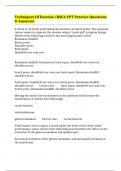NSCA-CPT Study guides, Class notes & Summaries
Looking for the best study guides, study notes and summaries about NSCA-CPT? On this page you'll find 241 study documents about NSCA-CPT.
Page 2 out of 241 results
Sort by
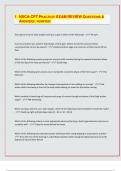
-
NSCA-CPT PRACTICE/ EXAM REVIEW QUESTIONS & ANSWERS. VERIFIED/
- Exam (elaborations) • 15 pages • 2024
-
Available in package deal
-
- $10.49
- + learn more
NSCA-CPT PRACTICE/ EXAM REVIEW QUESTIONS & ANSWERS. VERIFIED/ The optimal area for body weight training in a gym is which of the following? - -49 sq ft. A personal trainer was asked to help design a home gym. Where should the personal trainer recommend the mirrors be placed? - -Position bottom edge at a minimum of 20in (51cm) off the floor Which of the following muscle groups are concentrically involved during the upward movement phase of the lead leg of the step-up exercise? - -Quadri...
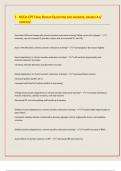
-
NSCA-CPT FINAL REVIEW QUESTIONS AND ANSWERS, GRADED A+/ VER| latest 2024/25 exams updates |IFIED/
- Exam (elaborations) • 72 pages • 2024
-
Available in package deal
-
- $10.49
- + learn more
NSCA-CPT FINAL REVIEW QUESTIONS AND ANSWERS, GRADED A+/ VERIFIED/ How does VO2max change with chronic aerobic endurance training? What causes this change? - - Increases, due to increased Q (cardiac output; due to increased SV, not HR) How is HR affected by chronic aerobic endurance training? - -Unchanged or decreased slightly Heart adaptations to chronic aerobic endurance training? - -Left ventricle hypertrophy and chamber diameter increases Coronary arteriole densities and diameters i...
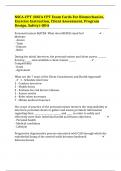
-
NSCA-CPT (NSCA CPT Exam Cards For Biomechanics, Exercise Instruction, Client Assessment, Program Design, Safety)-Q&A
- Exam (elaborations) • 8 pages • 2024
-
Available in package deal
-
- $10.49
- + learn more
NSCA-CPT (NSCA CPT Exam Cards For Biomechanics, Exercise Instruction, Client Assessment, Program Design, Safety)-Q&A
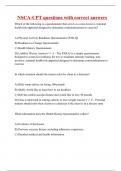
-
NSCA-CPT questions with correct answers
- Exam (elaborations) • 113 pages • 2023
- Available in package deal
-
- $12.99
- + learn more
Which of the following is a questionnaire that serves as a non-invasive, minimal health-risk appraisal designed to determine contraindications to exercise? A) Physical Activity Readiness Questionnaire (PAR-Q) B) Readiness to Change Questionnaire C) Health History Questionnaire D) Liability Waiver Answer A - The PAR-Q is a simple questionnaire designed to screen for readiness for low to moderate intensity training; non-invasive, minimal health risk appraisal designed to determine contraind...
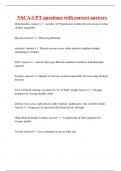
-
NSCA-CPT questions with correct answers
- Exam (elaborations) • 22 pages • 2023
- Available in package deal
-
- $16.49
- + learn more
Mitochondria Answer Aerobic ATP production within the cell occurs in what cellular organelles Myosin Answer Thick myofilament eccentric Answer Muscle action occurs when muscles lengthen despite attempting to shorten FOG Answer muscle fiber type that has moderate oxidative and anaerobic capacity Somatic Answer Branch of nervous system responsible for activating skeletal muscles 5.0 L of blood volume, accounts for 7% of body weight Answer Oxygen transport of average healthy adult ...
Techniques Of Exercise (NSCA-CPT Practice Questions & Answers)
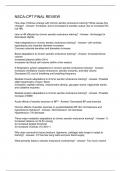
-
NSCA-CPT Final Review
- Exam (elaborations) • 50 pages • 2023
-
- $13.94
- + learn more
How does VO2max change with chronic aerobic endurance training? What causes this change? - Answer- Increases, due to increased Q (cardiac output; due to increased SV, not HR) How is HR affected by chronic aerobic endurance training? - Answer- Unchanged or decreased slightly Heart adaptations to chronic aerobic endurance training? - Answer- Left ventricle hypertrophy and chamber diameter increases Coronary arteriole densities and diameters increase Blood adaptations to chronic aerobic e...
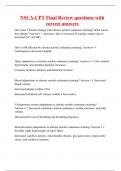
-
NSCA-CPT Final Review questions with correct answers
- Exam (elaborations) • 87 pages • 2023
- Available in package deal
-
- $17.99
- + learn more
How does VO2max change with chronic aerobic endurance training? What causes this change? Answer Increases, due to increased Q (cardiac output; due to increased SV, not HR) How is HR affected by chronic aerobic endurance training? Answer Unchanged or decreased slightly Heart adaptations to chronic aerobic endurance training? Answer Left ventricle hypertrophy and chamber diameter increases Coronary arteriole densities and diameters increase Blood adaptations to chronic aerobic endurance ...
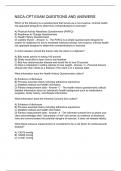
-
NSCA-CPT EXAM QUESTIONS AND ANSWERS
- Exam (elaborations) • 66 pages • 2023
-
- $13.99
- + learn more
Which of the following is a questionnaire that serves as a non-invasive, minimal health-risk appraisal designed to determine contraindications to exercise? A) Physical Activity Readiness Questionnaire (PAR-Q) B) Readiness to Change Questionnaire C) Health History Questionnaire D) Liability Waiver - Answer- A - The PAR-Q is a simple questionnaire designed to screen for readiness for low to moderate intensity training; non-invasive, minimal health risk appraisal designed to determine contra...
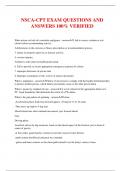
-
NSCA-CPT EXAM QUESTIONS AND ANSWERS 100% VERIFIED
- Exam (elaborations) • 27 pages • 2024
- Available in package deal
-
- $13.49
- + learn more
NSCA-CPT EXAM QUESTIONS AND ANSWERS 100% VERIFIED What actions (or lack of) constitute negligence - answer to screen, evaluate or test clients before recommending activity, iencies in the exercise or fitness prescription or recommendation process, 3. failure to properly supervise or instruct activity, 4. overuse injuries, re to refer client to health professional, 6. Fail to provide or secure appropriate emergency response for clients 7. improper disclosure of private info 8. Improper ...

That summary you just bought made someone very happy. Also get paid weekly? Sell your study resources on Stuvia! Discover all about earning on Stuvia



